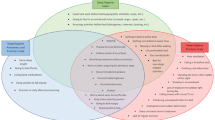The Sleep Hygiene Index was developed to assess the practice of sleep hygiene behaviors. The Sleep Hygiene Index was delivered to 632 subjects and a subset of the subjects participated in a readministration of the instrument. Test–retest reliability analyses suggested that sleep hygiene behaviors are relatively stable over time for a nonclinical population. Results confirmed that sleep hygiene is strongly related to sleep quality and modestly related to perceptions of daytime sleepiness. As predicted, support of the sleep hygiene construct was also provided by strong correlations with the associated features of a diagnosis of inadequate sleep hygiene. The Sleep Hygiene Index, a much shorter sleep hygiene instrument than previously published, demonstrated comparable psychometric properties with additional evidence of validity and a clear item selection rationale.

Similar content being viewed by others
REFERENCES
American Sleep Disorders Association (1990). International Classification of Sleep Disorders: Diagnostic and Coding Manual, American Sleep Disorders Association, Rochester, MN, pp. 73–77.
Blake, D. D., and Gomez, M. H. (1998). A scale for assessing sleep hygiene: Preliminary data. Psychol. Rep. 83: 1175–1178.
Bollen, K. B., and Lennox, R. (1991). Conventional wisdom on measurement: A structural equation perspective. Psychol. Bull. 110: 305–314.
Brown, F. C., Buboltz, W. C., and Soper, B. (2002). Relationship of sleep hygiene awareness, sleep hygiene practices, and sleep quality in university students. Behav. Med. 28: 33–39.
Buysse, D. J., Reynolds, C. F., Monk, T. H., and Timothy, H. (1989). The Pittsburgh Sleep Quality Index: A New Instrument for Psychiatric Practice and Research. Psychiatry Res. 28: 193–213.
Chervin, R. D., Aldrich, M. S., and Pickett, R. (1997). Comparison of the results of the Epworth Sleepiness Scale and the multiple sleep latency test. J. Psychosom. Res. 42: 145–155.
Diamantopoulos, A., and Winklhofer, H. M. (2001). Index construction with formative indicators: An alternative to scale development. J. Mark. Res. 38: 269–277.
Johns, M. W. (1991). A new method for measuring daytime sleepiness: The Epworth Sleepiness Scale. Sleep 14: 540–545.
Johnson, S. (1997). How sleepy are practicing physicians? A field trial of the Epworth Sleepiness Scale. Sleep Res. 26: 671.
Lacks, P., and Rotert, M. (1986). Knowledge and practice of sleep hygiene techniques in insomniacs and good sleepers. Behav. Res. Ther. 24: 365–368.
Leger, D. (1994). The cost of sleep-related accidents: A report for the National Commission on Sleep Disorders Research. Sleep 17: 84–93.
MacCallum, R. C., and Browne, M. W. (1993). The use of causal indicators in covariance structure models: Some practical issues. Psychol. Bull. 114: 533–541.
National Sleep Foundation (2002). Sleep in America Poll, National Sleep Foundation, Washington, DC.
Reynolds, C. F., Kupfer, D. J., and Buysse, D. J. (1991). Subtyping DSM-III-R primary insomnia: A literature review by the DSM-IV work group on sleep disorders. Am. J. Psychiatry 148: 432–438.
Riedel, B. W. (2000). Sleep hygiene. In Lichstein, K. L., and Morin, C. M. (Eds.), Treatment of Late-life Insomnia, Sage, Thousand Oaks, CA, pp. 125–146.
Stepanski, E. J., and Wyatt, J. K. (2003). Use of sleep hygiene in the treatment of insomnia. Sleep Med. Rev. 7: 215–225.
Streiner, D. L. (2003). Being inconsistent about consistency: When coefficient α does and doesn't matter. J. Pers. Assess. 80: 217–222.
Author information
Authors and Affiliations
Corresponding author
APPENDIX
APPENDIX
Sleep Hygiene Index Items
-
1.
I take daytime naps lasting two or more hours.
-
2.
I go to bed at different times from day to day.
-
3.
I get out of bed at different times from day to day.
-
4.
I exercise to the point of sweating within 1 h of going to bed.
-
5.
I stay in bed longer than I should two or three times a week.
-
6.
I use alcohol, tobacco, or caffeine within 4 h of going to bed or after going to bed.
-
7.
I do something that may wake me up before bedtime (for example: play video games, use the internet, or clean).
-
8.
I go to bed feeling stressed, angry, upset, or nervous.
-
9.
I use my bed for things other than sleeping or sex (for example: watch television, read, eat, or study).
-
10.
I sleep on an uncomfortable bed (for example: poor mattress or pillow, too much or not enough blankets).
-
11.
I sleep in an uncomfortable bedroom (for example: too bright, too stuffy, too hot, too cold, or too noisy).
-
12.
I do important work before bedtime (for example: pay bills, schedule, or study).
-
13.
I think, plan, or worry when I am in bed.
Rights and permissions
About this article
Cite this article
Mastin, D.F., Bryson, J. & Corwyn, R. Assessment of Sleep Hygiene Using the Sleep Hygiene Index. J Behav Med 29, 223–227 (2006). https://doi.org/10.1007/s10865-006-9047-6
Accepted:
Published:
Issue Date:
DOI: https://doi.org/10.1007/s10865-006-9047-6




